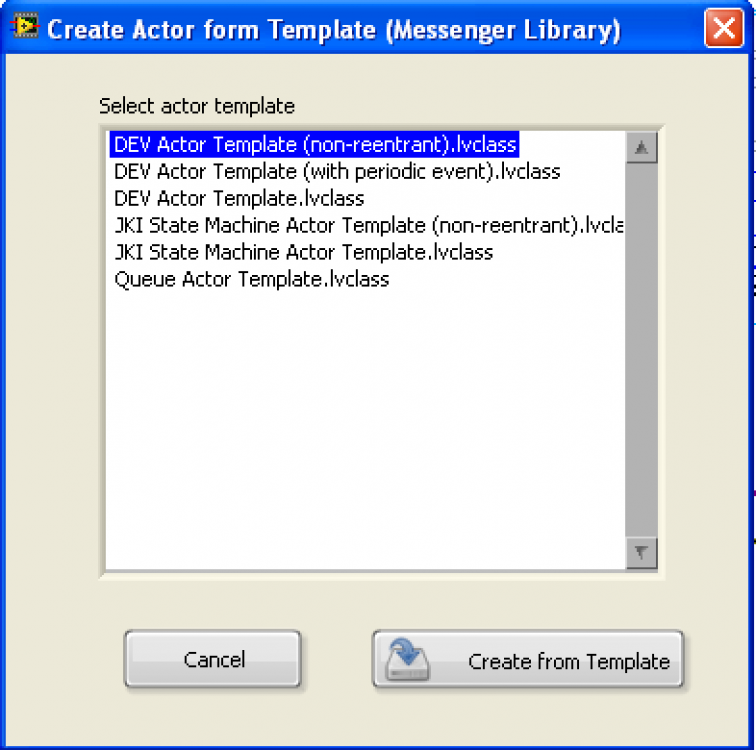-
Posts
1,986 -
Joined
-
Last visited
-
Days Won
183
Content Type
Profiles
Forums
Downloads
Gallery
Everything posted by drjdpowell
-
I haven’t had an RT project in several years, but if I had a new one I would probably stick to only a single (message-based) method of communication between RT and HMI, and possible only one instance of that. What do other people who do a lot of RT work do?
-

Interactive Webpage VI Options
drjdpowell replied to hooovahh's topic in Remote Control, Monitoring and the Internet
Question: Do these toolkits support events (such as Shortcut Menu events, Cursor Events, etc.) and do they work with subpanels? -

DVRs for accessing class private data
drjdpowell replied to shansen1's topic in Object-Oriented Programming
An advantage of many-to-one messaging is that, if you make the message receiver (the “oneâ€) the owner of the reference, then you don’t have to worry about reference lifetime at all. The secret there is the ability to wait on the reply to a message, and have any error passed back with the reply. With synchronous methods to send a message and wait for a reply one can interact with an asynchronous loop just as if it were an object. -

DVRs for accessing class private data
drjdpowell replied to shansen1's topic in Object-Oriented Programming
Another option, that I don’t think anyone has mentioned, is using a by-val object, but placing it in a DVR (rather than the DVR in the object. Then one can use the by-val object directly in one loop, or share it with a DVR among multiple loops. And you have the ability to call multiple methods on the object within a single IPE structure, which can protect you against race conditions. -

DVRs for accessing class private data
drjdpowell replied to shansen1's topic in Object-Oriented Programming
Messaging doesn’t actually cost anything (it’s just a pointer under the hood); it’s copying that can be expensive. If you pipeline, with A collecting data to pass to B (without A keeping a copy itself), then there isn’t any copying. Similarly, if you share data between loops with a DVR, but make a copy somewhere (to update an indicator, say), then you have the same overhead as if you had made a copy to send in a message. -

DVRs for accessing class private data
drjdpowell replied to shansen1's topic in Object-Oriented Programming
Are you sure that’s true? Why do they say DVRs should seldom be used. I rarely use them, but that's because I rarely share by-ref data between loops, by any method (I use messages, instead). -
I note that the SQL code to do arbitrary planer cuts through a 3D cube seems relatively straightforward, with a single large table and a simple WHERE statement ("SELECT … WHERE ABS(1.2*X+0.3*Y+.9Z) < tolerance", for example). So you should prototype that with a large dataset and see if the performance is sufficient. Also, don’t neglect the 3D picture control for visualization.
-
I think they mean creating Destinations set to LLB on the Destinations tab of the EXE build spec. I tried putting LVLIBs in these Destinations and it seems to work. Added later>> shoneil posted while I was experimenting.
-
Some of the presentations at the recent CLD Summit in Newbury, UK, were recorded by Steve Watts and are available on the CSLUG YouTube Channel.
-
Each plot can only be associated with one X scale; I’m not sure what the “normal†your referring to is.
-
Both your plots are on the same X scale, so the second X scale has nothing to autoscale to.
-

Scale Increment and the case of the marching plot area
drjdpowell replied to mje's topic in LabVIEW Bugs
Bug still present in LabVIEW 2015. I have reports of this issue in an app of mine, though I don’t touch the Yaxis properties at all. Does anyone know of other properties that trigger this issue? — James -
Notes on the 1.6 version: 1) there is a “Create Actor From Template†option under the Tool>>Messenger Library menu. the DEV template is what I mostly use, though there is also a JKI “Statemachine" version. 2) One can now make actors non-reentrant. To do this one must rename the “Actor.vi†to “ActorNR.vi†in addition to making it non-reentrant.
-

Challenge: figure out why this loop doesn't stop
drjdpowell replied to Sparkette's topic in LabVIEW General
Did you wire up the minus as 2-(shift reg), then move the wires around to make it look like (shift reg)-2? Then the shift reg would go 10, -8, 10, -8,… and never be less than -10. -
Well, the internals of the framework are not intended to be modified (or at least that would be a very advanced use). Application-specific code is meant to just be simple message-handling loops, with an API for passing messages. No LVOOP beyond copying a template class containing one “actor.vi†method. That those “actor.viâ€s are forced to be shared reentrant, with a resulting learning curve, is a problem. This conversation has lead me to reattempt a way to allow non-reentrant actors and I think I have a solution that works well, with the ability for a CLAD to more easily find his way through the code. I’m going to try it out in my current projects.
-
Exactly. They seem to me to be much harder for a CLAD to get to grips with than my async-called, shared-reentrant actors (though I am an XNode novice). Poor wording on my part. I don’t mean community standardization; I mean developer or team standardization on using a limited set of ways of doing things, so that one be expert in those techniques, and one can read and understand code quicker. I use my actors extensively, at multiple levels in my code. I don’t use techniques like “Action Engines†or any asynchronous calls of custom VIs, because I’m standardizing on Messenger Library actors. The actor I did just today is a small, one-VI-API “helper†that adds functionality to a WaveformGraph. It is based on the exact same actor template that is used by my “Top Level†main application, and is using the same standard techniques.
-
Is that how your CLAD programmer learns about your Xnodes? But your right, it is a problem. Even though I could show someone what to do in minutes, it’s easy to have no idea what the first step to do is. Fabiola is fighting that problem by providing several instructional videos for her new Delacor framework. I’ve been trying to develop a way to make my actors easily switched between reentrant and non-reentrant, so I can leave single-instance actors as more “just open and seeâ€. It hard, because I don’t want to give up other simplifying features, like auto-shutdown of actors. As Fab points out, one can also provide a junior developer simplicity via a simple API or set of tools that encapsulates complexity. And personally, I think there is simplicity in standardization, since there is so much effort in learning code structure.
-
The “Popout Window†actor was a bad example; there are multiple ways to handle UI windows. I meant a more generic “thing running in parallel that receives messagesâ€. The same app with the popout windows has a reconfigurable-on-the-fly chain of analysis actors that pass data messages between them. Actors are selectable from a list of plugins, and actors must be started and stopped as the User makes changes. Another example is a “TCP Connection†actor that is created for each connection made to a "TCP Listener†actor. One can, of course, make custom code for each case, with an asynchronous call and the setup of some kind of communication, but using a well-tested “actor†template gets one up and running quicker and with perhaps fewer bugs. I don’t really understand these benefits. The major point of “actors†is to make async easier to debug, so why do I not want the actual UI to be an actor? Every time I’ve tried making a custom async thing I’ve regretted not using my actor template. And I’ve never found opening and probing async actors difficult (they have a “Show Front Panel†message)**. — James **Haven’t worked with actors on RealTime, so it might be different in that case. No, they are just simple actors with a subpanel to hold a front panel. They allow adding behavior like adding custom right-click menu options, highlighting the window when the User hovered over an icon the represents the window in the main app, notifying a managing actor when the User closes the window, etc. All this could be done with dynamic event registration in a central component, which is why it is a poor example.
-
All this needs is the ability to specify terminal allowed types, including matching output types to inputs. For example: “A must be a string", "B must be a numeric", “output C must be the same type as input Dâ€, etc. Then it would be extremely useful (and would implement my long-declined idea).
-
That’s fine. I include the latest dll at time of package release for convenience, but you should be able to use any version. When building the EXE it goes in the “data†directory of the executable, and the “Open†vi looks for it there. This should happen automatically, but if not you can mark it as “Always Include†in the EXE builder.
-
Have you never had the use case of an arbitrary number of actors? “Restart†works if you want 0 or 1, but what about N, specified at run time? I made a “Popout window†UI actor just today to support an arbitrary number of independent windows in an application. The actors start as needed and shut down whenever the windows are closed.
-
Would that help you? They use Integers to store UNIX time, which has no partial seconds. I can certainly add a Bind Timestamp (Integer) and make Get Column as Timestamp accept integers. But how common is Julian days since 4714 BC? Not sure if that should override LabVIEW’s definition of a DBL timestamp, especially as this would be a breaking change in the library.
-
Is that a “bug� I used the LabVIEW time definition, as there is no SQLite Timestamp definition. Not sure why LabVIEW doesn’t match the UNIX definition.
-

Different dimensions for IMAQ Extract 2 vi
drjdpowell replied to jmakerofshoes's topic in Machine Vision and Imaging
Are you sure you’re not asking for 972x768 pixels from a 768x972 image?- 1 reply
-
- 1
-

-

Architecture Help - Actor Framework, State Machine?
drjdpowell replied to LewisG's topic in Application Design & Architecture
Another line of reasoning would be to ask why you have PID and Logging in the same actor. If a “PID actor†is only handling messages to do with PID control, then there may be advantages to keeping all actions serialized in one loop. BTW, Lewis, the AF group at NI.com is the best place to ask AF questions. More people who use the AF extensively will be watching.- 6 replies
-
- actor framework
- state machine
-
(and 1 more)
Tagged with:


